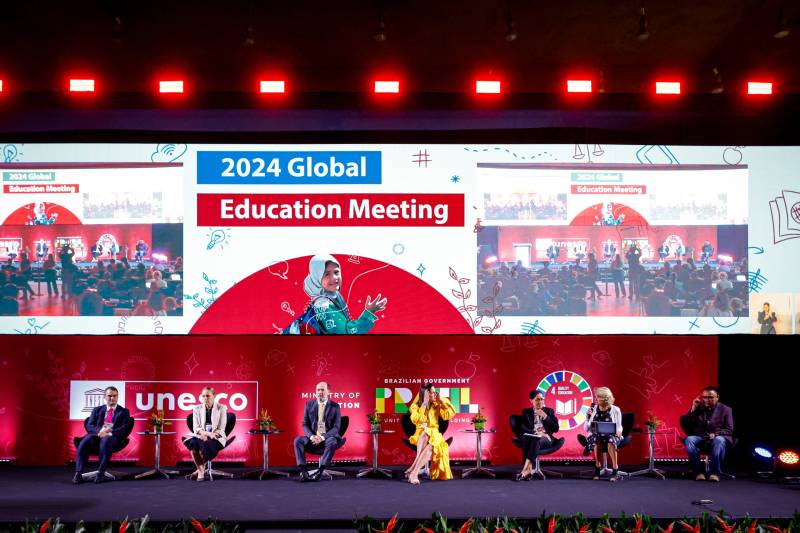Fortaleza, Brazil – A panel of distinguished school leaders from around the world sat on a giant stage earlier this month and listened to a depressing list of data points, from vast spending inequities to tales of lagging student performance. There wasn’t much hopeful news.
For starters:
- By 2030, an estimated 300 million children and young people will still lack basic numeracy and literacy skills.
- Four in 10 countries spend less than 15 percent of their total public expenditure and less than 4 percent of their gross domestic product on education.
- Some 251 million children and youth worldwide are still not in school, most of them poor and living in sub-Saharan Africa.
- For every $1 spent per child on education in the world’s poorest country, $100 is spent in the richest.
While the conversation clearly focused on a continuing worldwide crisis in education, the UNESCO conference I participated in was different. It emphasized a topic of huge importance to improving student outcomes, and coincided with the release of a report detailing how effective leaders can make a huge difference in the lives of children.
“We are all so different, but we are also uniquely alike. None of us have enough resources,” said Ryan T. Chee, the principal of Leupp Elementary School, the only school on the Diné reservation, as the Navajo Nation knows its people. It was Chee’s first time out of the U.S., and he began his remarks by addressing the crowd in his native Navajo language.
I had the privilege of moderating a session with Chee, along with officials from UNESCO, a mayor from Brazil and education ministers from Ecuador and the Democratic Republic of Congo, who spoke of small victories in improving student performance, against vastly different obstacles.
Chee, who is also a sheep farmer, runs an elementary school 45 miles northeast of Flagstaff, Arizona. Many children travel more than two hours each way from their homes on the reservation. They are immediately thrust into a culture of “No Excuses,” as part of the first Native American school to become a member of a nationwide college readiness program. He expects every one of his students to plan for a college education.
When Chee first began teaching at the school, he would ask his fourth grade students where they were going to college. “They had no idea,” he said. “I’d say what profession do you want to go into, and they would say, ‘What are you talking about?’ ”
Chee, who has also vastly improved literacy rates, takes his students to visit college campuses while they are still in elementary school. They eat lunch in a cafeteria at Arizona State University, where Chee is getting a doctorate, and learn about different programs and classes they might take. They “learn the logistics of a college application,” Chee said.
The conference gave me a chance to learn how UNESCO spends years compiling data and searching from common themes. I spoke with Manos Antoninis, who directs the Global Education Monitoring Report, which analyzes data used by policymakers around the world to strengthen their education systems. Because the conference took place before the election, we didn’t contemplate what will become of UNESCO’s relationship with the U.S. President-elect Donald Trump severed ties with the group during his first term. The relationship was re-established under President Joe Biden; Trump has said little about it since.
Antoninis said he hopes that the report will spark new ways to develop, recruit and support school leaders, many of whom who came to Brazil to swap success stories and learn from the inclusion of profiles and comparisons from more than 200 countries. Antoninis stressed the importance of reaching both the poorest and richest countries to collect data.
“An American reader should read the monitoring reports to open their eyes to the diversity in equality,” he told me. “You see it in your country, but not in the scale of how people live elsewhere, and in the low quality of learning. Some are just so far behind.”
It isn’t always easy to read through the lengthy reports and to sit through the drumbeat of bad news and hand wringing that often accompanies the latest unnerving education reports. I count on my colleague, Proof Points columnist Jill Barshay, to help interpret the latest NAEP and PISA results by explaining trends and pointing out problems that seem to have worsened since the global pandemic. That’s one reason why I look forward to moderating a discussion of resilience among worldwide education leaders in Hong Kong next month.
I’m hoping for the chance to meet more leaders like Chee, to get behind the numbers and to learn how a school leader can change lives. Chee told me that several of his students have graduated from college in recent years. He cherishes the moments.
“Some of my former students are now teachers, and they come into the classroom and visit us,” Chee said. “Or a family will come in and say, ‘Hey, my son is graduating from college; my daughter graduated,’ and it all started here.”
This story about school leadership was written by Liz Willen and produced by The Hechinger Report, a nonprofit, independent news organization focused on inequality and innovation in education. Sign up for the Hechinger newsletter.
Amid dismal data, educators from around the world gather in Brazil and say they can rise to the challenges. MindShift






